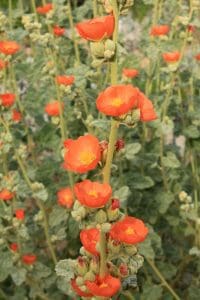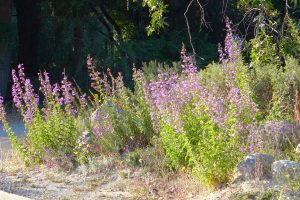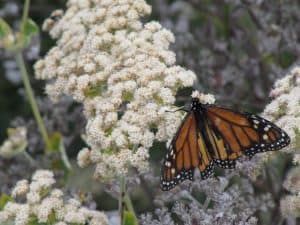Transition into Long Days with No More Rain

If you are familiar with California’s weather and environmental conditions, you know that the 5-month dry period between June and October is not considered a “drought.” It is considered “normal,” and it is contained in the very definition of a Mediterranean climate zone.
This is a key point if you are overseeing a natural garden. Most areas in southern California received in excess of 20” rainfall last season, and some places got double the average amount. This beautiful break in our drought (yes, five years of below average rain really was a drought) provided a generous replenishment of the precious soil moisture we had lost. Plants everywhere have responded, our gardens look great, and our natural areas experienced “super blooms” all spring long. As gardeners, June is the time we use to start locking in that moisture.
Watering
Choose a cool spell, a period forecast for June gloom, with overcast nights & mornings and cool temps. Utilize such a period to give your garden a thorough soaking. You can employ the pulse irrigation method by watering in early morning – three days in a row to apply a total equivalent of about 1.5+” precipitation. For most sprinkler systems this would require that you water about 20-40 minutes a day, for each of the three days, with cumulative run time of 1.5 to 2+ hours. You will not need to do this again for 3 or 4+ weeks. More detail on summer irrigation can be found in our May 2017 installment called May in the Natural Garden and in our watering guide here.
Pruning
Most of your pruning should have been done in May. See May in the Natural Garden. If you still need to prune, do it as soon as possible and follow the May guidelines. All the seed heads and unsightly old bloom on Ceanothus should be pruned off.

Feeding
No summer feeding for native plants. Shade gardens might be the exception, but only if the plants cannot wait for fall. Natives in containers can receive a light feeding in June. Of course warm-season growers including desert plants, especially in pots will benefit from a light application of an all purpose plant food.
Weeding
This is your big chore. Get all those winter weeds out of there. Use a hoe or pull them, the goal being to eliminate them now before they go to seed. Avoid the use of herbicides as much as possible. Tenacious stoloniferous or rhizomatous weeds may require chemical sprays, which are most effective during warm weather. To avoid harming your plants, avoid windy days (drift), hot days (the chemical can volatilize) and overspray at all costs.
Annual Wildflowers
See May in the Natural Garden.
Mulching
Be careful with mulch. If the lower branches of your shrubs and groundcovers are effectively shading the root zone, if natural leaf litter is building up under your plants, if the soil is clean and weed free, you do not need to apply new mulch. If any old mulch is still in place and seems adequate, leave it there but use a little three-prong cultivator or a stick or something to scratch it up, turn it over, and allow a little new air and new life in.
If you have bare soil and you have eliminated all your weeds and you feel you want to bring in organic mulch, use “bark chips,” not “wood chips,” and definitely not “compost.” “Bark chips” tend to originate in lumber mills as a single species by-product of timber production, while the less desirable “wood chips” often come from old crates, pallets, furniture and lumber of unknown origin. “Compost” is what we use to amend soil underground. We’ll talk more about compost during the fall planting season.
A layer 2-3” thick should be plenty. It should be chunky and gritty, not fibrous and stringy and not dusty and dry. It should have no foul odor. To prevent fungal problems, avoid piling it up near the crown of the plant or directly under any branches that touch the ground.
Adding New Plants
We have passed the end of the ideal planting time, so if you add any new plants, be ready to give them special attention through summer. In shade or in pots you can still have great success. Warm season growers and desert plants can certainly be handled safely in June.
Engage

The longest day of the year is right around the corner. Early mornings suggest a kind of anticipation as plants and animals await the sun. The mid day hours will prove that natives are both beautiful and tough with abundant blooms on sunflower, buckwheat and many desert plants. Late afternoons and evenings provide special opportunities to see birds and butterflies, beneficial pollinators and other garden residents moving about before nightfall. Even summer nights are magical in the natural garden. White flowers and silver leaved plants seem to glow in the moonlight.
Since we don’t experience our hottest weather until August and September, June could be considered a sort of prelude to summer. Start locking in that deep soil moisture, hoe the weeds, and get your garden ready for some hot weather. And definitely get out there to enjoy it. If you have a shady spot among the butterfly plants, you might find a chair for time in a good book, or just lay back and take a nap.
From the Garden,
Mike Evans
Call Us
Questions? Help is just one call or one email away. Call (949) 728-0685 or email (with pictures if you like) gardenhelp@californianativeplants.com.